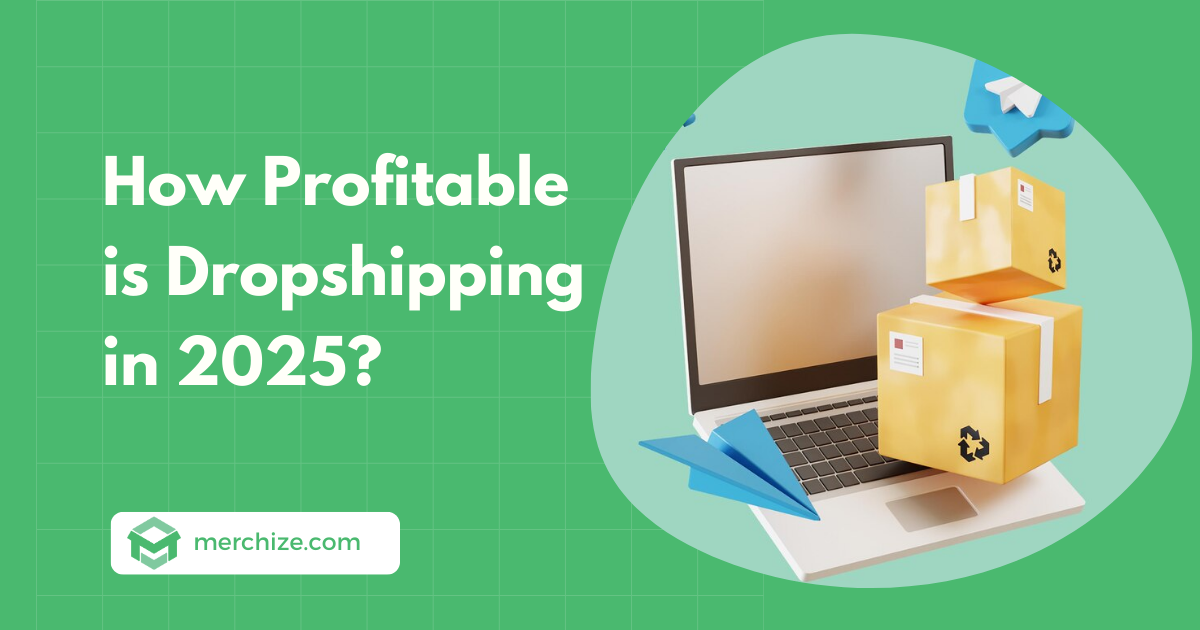Contents
When exploring popular ways to make money online, dropshipping consistently stands out. Known for low startup costs and minimal risks, it has attracted many new merchants around the world. However, many have the same question: How profitable is dropshipping in 2025?
In today’s article, we’ll answer this question and share some tips for a successful dropshipping business in 2025, ensuring you’re well-prepared to thrive in this ever-evolving landscape.
Without further ado, let’s dive into the details!
How Profitable is Dropshipping?
Before discussing the detailed answer to this question, let’s examine the trend over time.
As seen in the above chart, the number of people searching for the keyword “dropshipping" increased sharply from 2021 to 2022. Although the trend decreased significantly at the beginning of 2023, it has since recovered steadily, remaining relatively stable through 2024. This stability shows that while the initial surge may have peaked, the market has matured and we are now entering a phase where dropshipping offers both saturation and scalability.
According to statistics, global dropshipping observed a profitable result when reaching $276,71 billion in 2023 and is projected to grow at a CAGR of 23.20% by 2032. Interestingly, more than 30% of eCommerce stores use dropshipping to fulfill orders, and dropshippers contribute about 34% of Amazon sales.
So how profitable is dropshipping? On average, profit margins range from 15% to 20%, depending on the niche and product price. To be successful in dropshipping, choose your products wisely, market effectively, and partner with reliable suppliers.
Calculating Dropshipping Profits
When it comes to calculating profits in dropshipping, the formula is simple:
For example, let’s say you sell a product for $50. If your supplier charges $35, you’re left with a $15 margin. Out of that, you need to deduct marketing costs, transaction fees, and platform fees, which could easily reduce your margin to $5 per sale.
Hence, maximizing profits involves more than just applying the above equation. Let’s analyze each element and come up with strategies to ensure you’re optimizing both revenue and costs for high net profit.
1. Maximizing Revenue: Key Strategies
Generating revenue in dropshipping can seem like a difficult challenge for beginners. Let’s explore some strategies that you can take to drive more sales and make dropshipping worth it.
Product Selection & Pricing
Choose high-demand, high-margin products. Research market trends, focus on niche products that have less competition, and select items with a good balance between demand and profit potential.
Implement a strategic pricing model. Consider three main approaches:
- Cost-plus pricing: Add a fixed markup over your product costs to ensure profitability.
- Value-based pricing: Set prices based on perceived value to the customer, especially for high-end or niche products.
- Competitive pricing: Analyze your competitors’ pricing and adjust your rates to be more attractive while maintaining profitability.
Increase Average Order Value (AOV)
Upselling and Cross-selling are some of the best ways to help you increase your online store AOV efficiently. These strategies encourage customers to purchase higher-priced versions of products (upselling) or related items (cross-selling).
For example, if a customer buys a phone case, offer a screen protector at a discounted price in the same transaction. As a result, it will increase the amount customers spend per transaction, boosting overall revenue without needing to acquire new customers.
Repeat Business and Loyalty Programs
Build customer loyalty with excellent customer service and loyalty programs. Offering repeat customers special deals, discounts, or points for future purchases not only increases retention but also reduces marketing costs.
Optimize Marketing Campaigns
Utilize data-driven marketing to optimize your ad spend and focus on channels that offer the best ROI. Besides, analyze conversion rates and customer acquisition costs on platforms like Google Ads, Facebook Ads, or TikTok Ads, and refine your strategies accordingly.
2. Controlling Costs: Maximizing Profit Margins
In addition to maximum revenue, you must understand the costs involved and improve them in the best way. Let’s learn the main expenses: product and shipping costs, platform, and transaction fees.
Product and Shipping Cost
The first thing you can do to maximize product and shipping costs is to source reliable suppliers with competitive pricing. Additionally, building strong relationships with suppliers can lead to better rates, lower shipping costs, and faster fulfillment times. This can help you stay competitive and boost your profit margins.
Plus, you should offer free shipping strategically. While offering free shipping can increase conversions, fold shipping costs into the product price when possible. Moreover, focusing on lightweight items to keep shipping costs manageable is essential.
Platform and Transaction Fees
First off, minimize platform fees by choosing a solution that fits your business scale. For example, Shopify’s plans range from $29 to $299/month, and each level offers different features and transaction fees. Carefully calculate which plan makes the most sense for your business size and goals.
Eventually, consider alternative platforms like WooCommerce for lower upfront costs but remember to account for hosting and plugins that can add up.
Main Benefits of Dropshipping
Do you know that dropshipping generates more than 200% profits, compared to the traditional model? However, this is not the only reason more entrepreneurs participate in this business method. We will provide you with 4 most benefits of dropshipping below:
1. Low Startup Costs
One of the most attractive aspects of dropshipping is the low upfront investment required. That means new entrepreneurs don’t need to spend a lot of money on stocking inventory. Instead, you only purchase products from suppliers after you have an order, and they take care of everything from order fulfillment to shipping.
However, success in dropshipping hinges on more than just the business model. You should focus on strong promotional strategies and effective branding. To stand out, you’ll need to master digital marketing, build a unique brand identity, and consistently deliver value to your target audience.
2. Low Risk
Dropshipping removes the risks when purchasing and managing inventory. In traditional retail, businesses often face significant financial losses due to unsold products or high storage costs. But dropshipping allows you to avoid these pitfalls entirely. Since you only order inventory after a customer makes a purchase, there are no upfront stock costs, no storage fees, and no risk of inventory reducing your profit margins.
However, it’s important to understand that low risk doesn’t mean guaranteed success. Studies from AppScenic reveal that up to 90% of dropshipping businesses fail within the first 90 days. The key to avoiding this condition is a great strategy, strong marketing, and good customer support.
3. Wide Product Selection
When choosing a business model to start up, merchants might have difficulty in changing their product types to test customer demand. Besides, they will have trouble with inventory management and face unsold items. Meanwhile, dropshipping enables businesses to introduce a ton of products during the initial period. This way, startups can easily define what is the best product to attract customers.
4. Flexibility and Scalability
You may want to expand the business size when your store receives more orders. In this case, if you are a traditional retailer and want to scale your business, there are various problems such as hiring more storage space or recruiting more sales assistants. This will require you to try more to complete.
With dropshipping, scaling is more effortless than the traditional business model. Because it nearly does not affect the current situation of the business. Nevertheless, there is more workload and spending, but it is inconsiderable compared to traditional businesses.
Biggest Challenges of Dropshipping
Dropshipping has many advantages that attract many merchants, especially those with low budgets. However, if you want to participate in this market, you must consider the disadvantages of this model and determine whether you can afford it or not.
1. High Competitive
Since dropshipping is easy to start, anyone can join this market with minimal upfront investment. While this is a plus point for e-commerce beginners, it can also be a drawback with more and more people choosing this business model. That makes it competitive, even more so if you’re selling in a popular dropshipping niche.
With too many merchants jumping into dropshipping, finding a unique niche can be challenging. Established players already cover many product categories, which means new sellers must waste time in market research. Besides, identifying new opportunities and offering something different will be key to standing out from the competition.
2. Enormous Supplier Challenges
When running a dropshipping business, you might have to collaborate with multiple suppliers to find the best prices and product quality. Nevertheless, this can add complexity as working with different suppliers means tracking stock status, which is time-consuming and requires coordination. Moreover, constantly checking if products are in stock or discontinued can slow down your process.
3. Product Quality Control
One of the best benefits of dropshipping is no need to worry about the storage, packaging, and shipping process, but not everyone thinks so. This means you can’t check the product quality before it reaches your customers. Hence, if there are any problems with the product, you will be responsible for it.
On the other hand, dropshipping doesn’t allow you to customize and improve the quality of the product. Suppliers design and manufacture the products, so you can’t add or remove any components. The lack of customization means you can’t create anything unique for products.
How to Start a Dropshipping Business?
Reading here, you may figure out the answer to the question “How profitable is dropshipping?" as well as the benefits and challenges of dropshipping. It’s clear that dropshipping is still worth it, and from the looks of it, it will be for a couple of years.
If you decide to join this market, follow the main steps below:
1. Research Your Niche & Products
First off, you need to choose a niche to start your dropshipping business. You can target a niche with your store, brand, and product selection. This will help you identify a target audience, making it easier to look for product lines to dropship.
There are two main methods for choosing a niche:
- Select a niche that you’re knowledgeable or passionate about.
- Select a niche based on market demand.
You can based on your goal choose a suitable one for yourself. After choosing a niche, you should decide on suitable products. Below are some possible ways to pick your dropshipping products:
- Utilize tools: Google Trends, Google Keywords Planners, Facebook Audience Insights, Ahrefs, etc.
- Check marketplaces: Top-selling niches on Amazon, eBay, or Etsy are a great source to find profitable products with high demand and low competition.
- Consider seasonality: Seasonal trends and holidays can affect product demand greatly.
2. Understand Your Customer
Adapting your product selection, marketing messages, and entire business strategy to your customers’s needs and preferences is essential. To achieve this goal, you should create customer personas, including demographics, interests, pain points, and purchasing habits.
Apart from that, you need to conduct surveys, interviews, or social media research to collect your target customer feedback. Moreover, it’s also a good idea to study your competitor’s offering and their customer reviews. This can give you information to improve your business to be better than competitors.
3. Select a Reliable Supplier
Once you’ve determined your niche and products, you need to find a suitable dropshipping provider. They will help you manage inventory and organize shipping to customer addresses, so finding the best supplier is essential to success.
When conducting extensive research on potential suppliers, you should consider the following things:
- Their product offerings: High-quality products, diverse and true to description.
- Delivery options: Offer a variety of delivery options to suit every customer’s need.
- Order processing time: Accurate and fast order processing.
- Customer feedback: Lots of positive feedback from other merchants.
These factors will have a significant effect on product quality and customer satisfaction.
Finally, don’t forget to request sample products to test product quality before deciding to work with any provider. Furthermore, committing to multiple suppliers is a good idea to expand your product area and reduce the risk of supply chain disruptions.
4. Build an eCommerce Store
Building a professional eCommerce store is crucial for promoting your products effectively and reaching your target audience. Indeed, a well-designed store not only helps you showcase your products but also gains customer trust and boosts your conversion rates.
Plus, you can choose one of the most trusted e-commerce platforms for dropshipping like Shopify, WooCommerce, and BigCommerce. After that, optimize your product pages with high-quality photos, detailed descriptions, and convincing content to convert your customers. Moreover, equally important user experience factors like seamless navigation, mobile responsiveness, and secured payment also help you increase your conversion rates.
5. Market Your Business
To stand out in this competitive marketplace, having great suppliers and a ready-to-launch store is just the beginning. No product sells itself, especially in a crowded market. To succeed, it’s essential to actively promote your dropshipping business and attract the right customers.
In this case, a great marketing strategy can make all the difference to your dropshipping business. Combine digital marketing tactics, including social media, email marketing, and SEO to find what resonates with your audience. Don’t forget to analyze your results, and adjust your approach for better performance, ensuring your marketing efforts grow with your business to drive sustainable growth.
Tips for A Successful Dropshipping Business
Once your dropshipping business runs, it’s time to pay attention to marketing. A perfect marketing strategy that brings more traffic to your store will allow your dropshipping store to succeed. Here are some tips to help you maximize the benefits of your dropshipping store:
1. Master Your Marketing Efforts
Since dropshipping allows you to operate without the overhead of physical stores, your online presence is the key to generating revenue. However, a big challenge for beginners is driving traffic to their websites, especially in the first 6-12 months when brand awareness is low. During this phase, it’s crucial to prioritize marketing efforts to attract visitors and build your trust. By investing in targeted digital marketing strategies, you’ll not only increase traffic but also establish your brand and create a foundation for long-term growth.
2. Automate Your eCommerce Store
Many eCommerce platforms can help you automate your store, but if yours doesn’t, don’t worry. There are easy-to-use plugins that allow you to automate your dropshipping business. They can handle important tasks like processing customer orders, checking inventory, confirming orders, and sending shipping estimates to your customers. Using these tools can save you time and make your business run more smoothly.
3. Focus on Customer Service
High-quality products, fast shipping, and a great marketing strategy are not enough to convince customers to repurchase at your store. One thing you need to do to drive sales and build a successful dropshipping business is to provide professional customer support.
To offer exceptional customer support, you can follow the below tips:
- Have a positive, can-do attitude in any situation
- Respond quickly to customer inquiries
- Always follow up after a customer interaction
You might want to read:
Top 10 Best Dropshipping Platforms for Beginners
How to Dropship Personalized Products
Branded Dropshipping: The Complete Guide
Dropshipping vs Print on Demand: Which is the best for your online business?
Best Methods To Do Dropshipping Product Research and Find Winning Products














